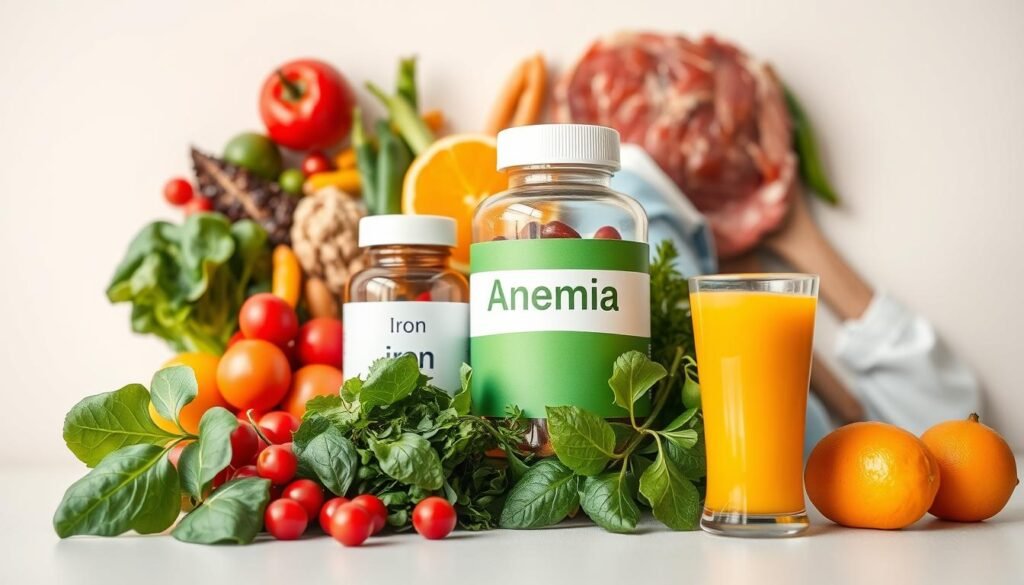Ever feel tired and think it’s just because you’re busy? It might be something more. Anemia affects millions worldwide. It happens when there aren’t enough healthy red blood cells in your body. This leads to various symptoms like feeling tired all the time and shortness of breath. These problems can make daily tasks hard and lower your quality of life.
Anemia comes from many causes, including not getting enough iron, vitamin B12, or folate. It can also stem from long-term illnesses or inherited conditions. Knowing the cause is key to dealing with anemia. Treatments might include changing your diet, taking supplements, or possibly medication. It depends on the kind of anemia you have.
Looking for deeper insights? The Mayo Clinic offers detailed information about anemia’s causes, symptoms, and treatment options. It’s a great resource for understanding this condition better.
Key Takeaways
- Anemia is characterized by insufficient healthy red blood cells.
- Fatigue and weakness are common symptoms of anemia.
- Nutritional deficiencies, chronic conditions, and genetics can lead to anemia.
- There are various effective treatment options available.
- Maintaining a diet rich in iron and essential vitamins can help prevent anemia.
- Awareness of symptoms is critical for timely diagnosis and management.
What Is Anemia?
Anemia means not having enough hemoglobin or red blood cells in your blood. It’s a serious health issue that affects many people around the world. If you feel tired, weak, or notice your skin looks pale, you might be experiencing symptoms of this blood condition.
Knowing about anemia is important because it can really change how you live day to day. People with anemia often feel too tired to do regular activities. This makes it hard to stay motivated and do daily tasks.
Many things can lead to anemia, like not eating the right foods or long-term illnesses. By understanding these causes, we can work on ways to avoid or deal with anemia. It’s important for doctors and those affected to quickly recognize and treat anemia. This helps lessen its effects on one’s life.
Types of Anemia
Anemia has several different types, each with their own causes and traits. It’s key to know these differences to find the right treatment. This part explains four main types: iron deficiency anemia, vitamin deficiency anemia, aplastic anemia, and hemolytic anemia.
Iron Deficiency Anemia
Iron deficiency anemia is the most common type globally. It happens when you don’t eat enough iron. Without iron, your body can’t make hemoglobin, which carries oxygen in blood. Not eating enough iron-rich foods leads to symptoms like fatigue, weakness, and a pale complexion.
Vitamin Deficiency Anemia
This anemia is due to not getting enough vitamins, mostly B12 and folate. These vitamins are crucial for making red blood cells. Problems like pernicious anemia affect B12 absorption and need careful handling. People may feel numb, struggle to keep their balance, and have trouble thinking clearly.
Aplastic Anemia
Aplastic anemia is serious and rare, with the bone marrow not making enough blood cells. It can happen due to chemicals, radiation, or immune system issues. Signs of this include getting sick often and bruising easily.
Hemolytic Anemia
In hemolytic anemia, red blood cells are destroyed faster than they’re made. This can be due to genetic problems, certain drugs, or infections. Common symptoms are yellowing skin, dark pee, and a fast heartbeat as the body tries to make up for lost blood cells.
| Type of Anemia | Common Causes | Symptoms |
|---|---|---|
| Iron Deficiency Anemia | Insufficient dietary iron | Fatigue, weakness, pallor |
| Vitamin Deficiency Anemia | Lack of vitamin B12 or folate | Numbness, balance issues, cognitive disturbances |
| Aplastic Anemia | Chemical exposure, radiation, autoimmune diseases | Frequent infections, excessive bruising |
| Hemolytic Anemia | Inherited disorders, medications, infections | Jaundice, dark urine, elevated heart rate |
Understanding Anemia: Causes and Risk Factors
To manage and treat anemia well, we need to know what causes it. Many factors, like genetics and what we eat, play a part. Knowing these risks helps stop anemia early and prevent it.
Genetic Factors
Genes make a big difference in whether you might get anemia. Diseases from your genes, like sickle cell disease and thalassemia, make it hard for your body to make healthy hemoglobin. This leads to ongoing anemia needing treatment. If your family has these issues, your risk goes up.
Dietary Deficiencies
What you eat also affects your chance of getting anemia. Not eating enough of certain nutrients can lead to anemia. Iron, vitamin B12, and folate are especially important for making hemoglobin. Eating foods rich in these can lower your anemia risk.
| Type of Anemia | Causes | Risk Factors |
|---|---|---|
| Iron Deficiency Anemia | Low iron intake or absorption issues | Vegetarians, pregnant women |
| Vitamin Deficiency Anemia | Insufficient vitamin B12 or folate | Older adults, certain medical conditions |
| Aplastic Anemia | Bone marrow failure | Genetic predisposition |
| Sickle Cell Anemia | Inherited genetic mutation | Family history, African ancestry |
Symptoms of Anemia
It’s important to notice anemia symptoms early. Common signs are fatigue, weakness, and pale skin. These can be easy to miss or mix up with other conditions. Knowing these signs helps in quick diagnosis and better treatment results.
Common Symptoms to Watch For
Anemia can change how people feel daily. Key signs to look out for include:
- Fatigue – An overwhelming tiredness that rest doesn’t help.
- Pale skin – Lighter skin color can show low hemoglobin levels.
- Dizziness or lightheadedness – Often happens when you’re active.
- Shortness of breath – Even light activities can make breathing hard.
Symptoms in Children and Adults
Adults and kids may show anemia signs differently. In children, watch for:
- Behavioral changes – Look out for more irritability or being very tired.
- Poor appetite – Eating less or not wanting meals.
Adults might face physical challenges and a big impact on their daily work. Knowing these differences helps spot anemia in people of all ages, leading to quicker help.
| Symptom | Adults | Children |
|---|---|---|
| Fatigue | Persistent tiredness | Increased sleepiness or lethargy |
| Pale Skin | Noticeably lighter complexion | Palms and eyelids may appear pale |
| Dizziness | Lightheaded during activity | May fall or have trouble balancing |
| Behavioral Changes | Less common | Frequent irritability |
Diagnosis Methods for Anemia
Doctors use several steps to find out if someone has anemia. They start with a complete blood count (CBC). This test checks hemoglobin and hematocrit levels to see if a person is anemic.
Blood tests are key to figure out the type of anemia someone has. For instance, low iron might mean iron deficiency anemia, and odd red blood cell shapes could point to hemolytic anemia. They might also do a reticulocyte count and iron studies to get more details.
Knowing how to diagnose anemia helps doctors classify it correctly. This way, they can choose the best way to manage it. Finding anemia early is important. It helps treatments work better and improves how patients feel overall.
Treatment Options for Anemia
Treatment for anemia depends on what caused it and how serious it is. It usually means taking certain medicines for anemia. Changes in how you live are also recommended. This approach helps with recovery and managing symptoms.
Medications and Therapies
Doctors often prescribe medications for anemia like iron supplements, vitamin B12 shots, and folic acid pills. These help fix what’s missing in the body that could be causing anemia. Every treatment is tailored to the patient’s needs. So, it’s important to talk to a doctor before starting any medicine.
Blood Transfusions
For severe anemia, blood transfusions can be crucial. This process quickly brings hemoglobin levels back to normal. It also helps more oxygen get around the body. Transfusions are vital when anemia is very bad and must be dealt with right away. Patients should work with their doctors to find the best treatment for their unique situation.

Dietary Recommendations for Preventing Anemia
Eating right plays a key role in preventing anemia. Adding foods high in iron, vitamin B12, and folate to your diet can help avoid the nutritional shortages that lead to anemia. Here’s a guide on how to get these important nutrients every day.
Foods Rich in Iron
Iron is key for making hemoglobin, which lets red blood cells carry oxygen. To raise iron levels, focus on iron-rich foods. Great choices include:
- Red meat (beef, lamb)
- Poultry (chicken, turkey)
- Fish and seafood (tuna, shrimp)
- Legumes (beans, lentils, chickpeas)
- Fortified cereals and grains
- Nuts and seeds (pumpkin seeds, cashews)
Vitamin B12 and Folate Sources
Getting enough vitamin B12 and folate is crucial for making red blood cells. The top sources for these nutrients are:
| Vitamin B12 Sources | Folate Sources |
|---|---|
| Fish (salmon, trout) | Leafy greens (spinach, kale) |
| Dairy products (milk, yogurt) | Legumes (black-eyed peas, lentils) |
| Eggs | Citrus fruits (oranges, grapefruits) |
| Fortified cereals | Brussels sprouts |
To ward off anemia, it’s smart to mix these foods into your meals daily. Making meals with a range of iron, vitamin B12, and folate sources ensures you cover your nutritional bases.
Anemia in Pregnancy
Pregnancy often leads to different health issues, anemia being a common one. A pregnant woman needs more iron to help her baby grow and keep her blood healthy. If she doesn’t get enough iron, it can cause anemia. This makes her very tired and can harm both her and the baby. It’s important to know why this happens and what it means for her health.
Causes and Implications
Anemia in pregnancy can happen for a few reasons. Not eating enough iron, vitamin B12, and folate are big causes. Pregnant women need more of these nutrients. If anemia isn’t treated, it could cause the baby to be born too early or too small. It might also affect the baby’s development. Pregnant women should watch their health and get help early from doctors.
Recommended Treatments
Treating anemia during pregnancy requires a few steps. First, recognizing the symptoms is key. Then, doctors usually suggest iron pills, vitamin B12, and folic acid. Eating foods high in iron is also a good idea. Regular check-ups help doctors catch and treat anemia early. This ensures both the mom and baby stay healthy.

Prevention Strategies for Anemia
Preventing anemia boosts health and well-being. A key method is having regular health check-ups. These checks can catch deficiencies early, leading to prompt action.
Regular Health Check-Ups
Seeing a doctor regularly is crucial. They can run blood tests to spot anemia or nutrient shortfalls. Keeping track of hemoglobin and regular visits help catch anemia early, making treatment more effective.
Maintaining a Balanced Diet
Eating right is vital to fight anemia. Include foods rich in iron, vitamin B12, and folate. These nutrients build the body’s defense against anemia. Pay attention to certain foods to boost your diet:
- Leafy greens such as spinach and kale
- Lean meat, eggs, and fish
- Citrus fruits for vitamin C
- Legumes like beans and lentils
Adopting these dietary practices is a big step toward anemia prevention. It helps fulfill nutritional requirements, keeping anemia at bay.
How Anemia Affects Daily Life
Anemia really changes how you live. It makes everyday jobs hard because of tiredness and feeling down. People with anemia often find simple tasks tough, affecting their day.
Physical Limitations
Feeling tired and weak is common with anemia, making it hard to stay active. Since anemia makes it tough for your blood to carry oxygen, you might struggle to do normal things. You may feel:
- Difficulty in performing physical tasks
- Reduced stamina during exercise
- Increased need for rest and breaks
These physical limitations can make you less productive at work and less interested in hanging out with friends. Understanding anemia helps you handle these challenges better, according to health experts like Mayo Clinic.
Mental Health Impact
Anemia doesn’t just affect your body, it can also hurt your mental health. It can make you feel anxious or depressed, being sick all the time. It’s important to look after your mental well-being too.
Worrying about how you’ll feel each day can make mental health worse. For more info, check out Be Healthy to Live.

It’s key to care for both your body and mind when you have anemia. Getting the right treatment and finding support can help you live better.
Long-Term Implications of Untreated Anemia
It’s important to know how untreated anemia affects health over time. This condition can cause major health issues if not managed. Knowing the risks makes it vital to get help early.
Potential Health Complications
Having chronic untreated anemia can lower your quality of life. Risks include:
- Increased risk of heart disease due to the heart working harder to compensate for low oxygen levels.
- Possible developmental delays in children affecting growth and cognitive function.
- Pregnancy complications that can endanger both the mother and the fetus.
These health complications show that untreated anemia can cause serious problems over time. Medical studies urge us to monitor anemia. This helps avoid its long-term effects. Find out more through anemia treatment and prevention resources.
Doctors say it’s crucial to deal with untreated anemia early. Knowing the risks can push us to take care of our health. It reminds us to get the treatment we need.
Research and Future Directions in Anemia Treatment
Research into anemia is making fast progress, helping health experts discover better treatments. Ongoing anemia studies underline the need to understand genetics in anemia. This knowledge leads us to new treatments that tackle the real causes, not just symptoms.
Clinical trials play a big role in these advances. They show how personalized medicine can change the way we treat diseases. The success of these trials might bring treatments more suited to each person’s needs, making them more effective.
There’s a lot of interest in new drugs that target, specific pathways in anemia. These therapies are designed to be more direct, reducing the usual side effects.
As more patients learn about anemia, they want better care. This pushes doctors to use the latest research in their work. Better testing, like genetic tests, adds to our knowledge of anemia. It helps pave the way for new research and advanced treatments.
Conclusion
This article covered the many aspects of anemia, from its types and causes to how to manage it. Knowing about different kinds of anemia is key to dealing with the condition well. It’s very important to spot the early signs to get help quickly, which can make a big difference in health.
It also talked about how to prevent anemia. Eating right and going for health checks often can lower the risk. Focusing on both treatment and avoiding the condition helps everyone to look after their health better.
As people learn more about anemia, they can handle it better. Knowing what symptoms to look for, the risks of not treating it, and getting help can improve life quality. Public health gets a boost when everyone knows more, and more resources become available for those who need them.